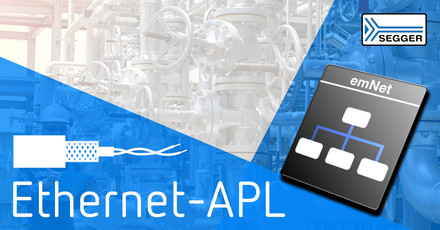Ethernet-APL
Ethernet-APL is a new international standard for wired digital communication. It enables high performance and long range data transmission and is optimized for use in the process industry.
Overview
Ethernet-APL is the standardized Ethernet Advanced Physical Layer (APL) for 2-wire data transmission. It is based on the Single Pair Ethernet (SPE) standard 10BASE-T1L as defined in the amendment IEEE 802.3cg-2019 and is specifically expanded for use in the process industry. It enables consistent and fast IP communication over long cable lengths (up to 1000 meters) from the field level to the control system, and meets reliability, security and safety requirements necessary for the operation in the field of process plants.
Ethernet-APL ensures protocol transfer and power supply via a single twisted-pair (2-wire) cable while providing protective measures for safe operation within hazardous areas. It is designed to support different installation topologies with optional redundancy or failover concepts. According to IEC specifications, it also supports the validation, installation and implementation of the safe operation of field instruments.
Ethernet-APL provides the Network Access Layer of the TCP/IP model, connecting to the higher layers of the model provided by SEGGER’s IP stack emNet. In combination with ultra-low-power microcontrollers, emNet offers maximum performance with minimal memory requirements and simple integration without configuration effort. It is capable of providing excellent network performance while at the same time also being highly efficient in terms of flash, RAM, and overall processing speed and is therefore a perfect match even for small, low-frequency ultra-low-power microcontrollers.
Key features
- Transmission of data and power via 2-wire cable (Single Pair Ethernet)
- Fail-safe communication, including power supply in Ex zones 2/1/0
- High data flow rate through 10 Mbit / s full-duplex communication
- Increased bandwidth compared to previous fieldbuses
- Wide-ranging including trunk lengths of up to 1,000 meters and spurs of up to 200 meters
- Supply of up to 50 field devices with up to 60 W
- Download of approx. 100 configuration parameters in just a few seconds per field device
- Support of the protocols EtherNet/IP, HART-IP, OPC UA, PROFINET
- Protection type intrinsic safety easy to apply for installation in highly explosive environments
Intrinsic safety
Ethernet-APL has been specifically designed for applications in highly explosive environments, such as refineries or petrochemicals plants. It meets the requirements of the IEC standards IEC 60079-11 and 60079-25 which regulate equipment protection of apparatuses and electrical systems in explosive atmospheres. Ex i Intrinsic Safety is an explosion protection concept in which the electrical energy within the equipment is restricted to a level below that what may cause an ignition or to limit the heating of the surface of the hazardous area equipment.
Widely applicable
Ethernet-APL creates the technological basis for a uniform infrastructure for safety and non-safety systems. Field components from non-safety infrastructures can be directly transferred to safety systems. Ethernet-APL ensures physical separation of the two systems which increases diversity and independence of hardware and software and, in turn, increases availability. The flexible Ethernet architecture, in which the failure of individual devices has no effect on the overall system, also contributes significantly to the safety of a plant.
Simple device management
Ethernet-APL does not require a gateway and thus allows access and analysis of process data in real-time of devices from different manufacturers, independent of the running process and without restrictions. This may include data for self-diagnostic functionalities, for instance. If a device has to be replaced, it is possible to set up the replacement device completely digitally. This results in reduced costs for maintenance and service by eliminating the need for protocol converters, additional system components or retrofit solutions.
Use cases
Process reliability for smart field devices
Ethernet-APL enables innovative network concepts for process automation. The prerequisites for this are fast and consistent digital communication over all levels, the interoperable deployment of field devices, or the analysis of data already available. Last but not least, devices and connection technology should function for several decades and must be repairable, especially at night and in bad weather.
Ethernet-APL will dramatically change the industry by greatly improving operational efficiency through seamless Ethernet connectivity to field-level assets. The following customer story shows how an extended physical Ethernet layer and SEGGER’s IP stack emNet lay the groundwork for future smart field devices from Siemens:
SEGGER emNet supports Siemens’ smart Ethernet-APL field devices for the process industry
Operation safety in explosion hazard areas
Ethernet-APL comes with suitable protection concepts for highly combustible environments and its intrinsically safe field devices in so-called Ex areas. This is the case, for instance, in the oil, gas, chemical, petrochemical and pharmaceutical process industries that handle highly flammable and explosive substances. Damage and potential ignition risks must be absolutely avoided so that electronic devices, cable or conduit routings, etc. do not cause an explosion.
In particular, radio-capable equipment such as WLAN access points, mobile radio components or RFID readers involve electrical ignition hazards. With the ignition protection Ex i for both all installed devices and (radio) interfaces, electrical energy is reduced to a non-ignitable level by limiting currents and voltages. This is particularly advantageous for temporary installations, retrofitting of existing systems and data exchange with terminals.
Evaluate Ethernet-APL out of the box — It simply works
Together with Analog Devices, SEGGER has developed an out-of-the-box solution for the evaluation of Ethernet APL.
The required components are the following:
- Evaluation board EVAL-ADIN1100EBZ
- Evaluation board EVAL-ADIN1110EBZ Rev. B
- Evaluation software package from SEGGER
- Debug probe to transfer the software to the STM32L4S5QII3P ultra-low-power microcontroller on the evaluation board, we recommend a model of the J-Link family from SEGGER
The software package contains only components of SEGGER's all-in-one operating system emPower OS, proven over many years and developed from the ground up for embedded applications. These components stand for minimum memory requirements, highest speed and greatest reliability and have been proved in billions of devices.
